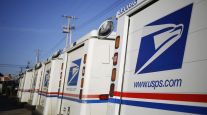Eying ‘Featherweight’ Parcel Niche, Postal Service Launches Regional Service
This story appears in the May 2 print edition of Transport Topics.
The U.S. Postal Service, angling for a bigger slice of the parcel market, has started a ground-based regional delivery service aimed at high-volume, business-to-consumer shippers selling retail goods online.
The service, Parcel Select Regional Ground, is for packages that are 5 pounds or lighter and smaller than 0.35 cubic foot — a type of shipment sometimes called a “featherweight” parcel. Shippers have to commit to 10,000 pieces annually in order to use the service.
“This new service is designed as a solution for e-commerce merchants looking to boost sales by offering free or discounted shipping charges for online purchases,” said Gary Reblin, vice president, Domestic Products.
USPS officials said they did not have projections about how many parcels would be moved this year.
“Regional” shipping typically means a delivery radius of about 150 to 200 miles from a national distribution center. All Parcel Select Regional Ground shipments must be dropped off at distribution centers.
The number of featherweight shipments bound for residences has soared with the proliferation of online retailing. Web-based stores are now trying to entice shoppers with cheap delivery rates, and USPS believes the strategy plays to its strength as a bargain delivery service for cost-sensitive customers, a parcel-industry analyst said.
“From a pricing point of view, the current parcel carriers and parcel rate structure doesn’t recognize the slightly lower cost of handling” these featherweight shipments, said Satish Jindel, president of SJ Consulting Group in Sewickley, Pa.
Shipments that weigh 5 pounds or lighter and have a residential address make up about half of the total U.S. parcel volume, Jindel estimated. He said there are about 15 million parcels shipped every day in the United States.
In addition to businesses, the Postal Service hopes the new service will pull more parcels into its distribution centers by way of third-party consolidators, such as UPS Inc., FedEx Corp. or other logistics providers.
“Gaining new business from consolidators is definitely part of our competitive strategy for this package service,” said Dave Lewin, a USPS spokesman.
The Postal Service competes with UPS and FedEx, but lags behind both in terms of its share of U.S. parcel volumes.
USPS is also struggling financially, having lost $8.5 billion in its 2010 fiscal year, which ended Sept. 30. The year before, it lost $3.8 billion. It projects a loss of $6.4 billion for the 2011 fiscal year.
In spite of competing with the private sector, USPS has relied on private contractors not only to deliver the mail but to help get freight into the delivery system.
Today, the biggest postal contractor is FedEx Corp., the second-largest for-hire truck fleet in the country and one of the largest airlines in the world. FedEx provides airlifts for express packages and smaller mail in the Postal Service network.
UPS Inc. recently partnered with the U.S. Postal Service to create a hybrid offering that uses UPS’ ground network in conjunction with USPS. UPS also handles return shipments to businesses that consumers drop off at post offices, and the Postal Service hands off to UPS at a postal distribution center.
USPS also did some business with DHL previously. In 1999, DHL and USPS partnered on a U.S.-to-Europe package-delivery service that, at the time, undercut the rates charged by UPS and FedEx for packages weighing 70 pounds or less.



